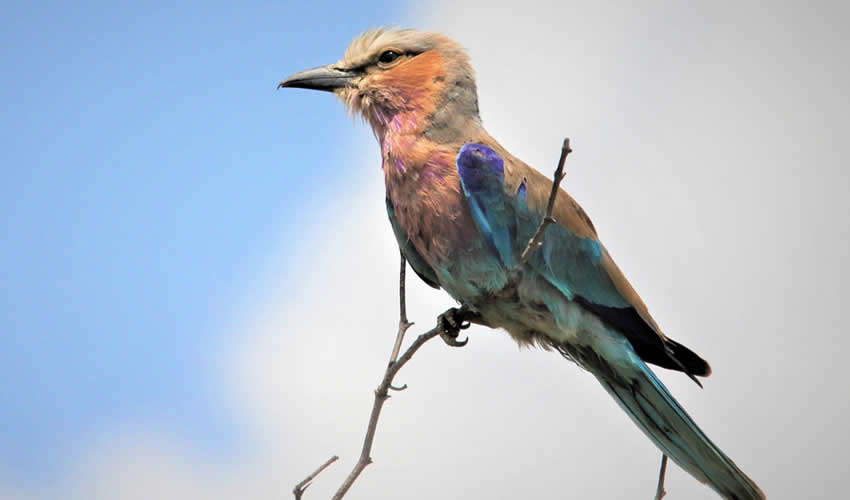Uganda-a land-locked country, a Paradise with an outstanding array of extraordinary bird species for Bird Watching Tours. During bird watching tours in Uganda, plethora of bird species change as you journey across the verdant Tropical rainforests, savannah plains, mountains, wetlands/swamps, Valleys and Rivers/Lakes. From migratory, range-restricted to other species of birds, Uganda is truly magical with over 1066 species of birds (representing 11% of the World’s total bird species and 60% of Africa’s total bird species).
 Common bird species in Uganda: Bird Watching Safaris
Common bird species in Uganda: Bird Watching Safaris
With a total of 1066 bird species occupying different habitats-forests, wetlands, water bodies, woodlands and savannah plains, it is difficult to come up with a comprehensive list of common birds in Uganda. However, the most popular species of birds in Uganda are the stunning shoebill storks, the Standard-winged Nightjar, African Spoonbill, Great blue Turaco, Saddle-billed storks, Long-crested Eagles, grey-crowned Cranes (National bird popularly known as the Crested Cranes), African Green Broadbill, Shelley’s Crimson wing, Chocolate-backed Kingfisher, Marabou storks, Doherty’s Bush shrike, Ostriches, African grey parrot, Green-breasted Pitta, Bar-tailed Trogon, Yellow-billed Oxpeckers and Black bee-eaters among others.
Top birding spots in Uganda, Bird Watching Safaris destinations
In whatever corner of Uganda you are visiting, you cannot lack choice of birding spots because every area offers birding opportunities. However for your bird watching tours in Uganda, just grab your binoculars and slow down for heroic spectacles of nature in these Natural wonders for birding.
Queen Elizabeth National Park
Over 600 species of birds (60% of Uganda’s total bird species) call Queen Elizabeth National Park. If you are looking for the shoebill storks, Papyrus gonolek, Flamingos, Pelicans and the white-headed barbets, this 1978-square kilometer Park will offer you numerous opportunities for beautiful photos.
Bwindi Impenetrable National Park
Whether you are trekking mountain gorillas, having guided forest walks or undertaking a community tour, there is no shortage of these feathered beauties. There are over 357 species of birds in Bwindi including 23 species that are Albertine Rift endemics. Look out for the handsome francolins, Kivu ground thrush, Rwenzori batis and Hairy-breasted barbets among others.
Kibale Forest National Park
Uganda obviously has numerous birding places but Kibale Forest National Park is another outstanding birding spot because Afro-tropical highland biome species, Lake Victoria Basin Biome, Guinea-Congo forest Biomes and Sudan-Guinea savannah birds form part of the Park’s 335 bird species.
Other popular birding spots in Uganda with spectacular birding opportunities are Budongo Forest, Mabamba Swamp, Bigodi wetland Sanctuary, Mabira Forest, Kalinzu and Maramagambo forests, Lake Mburo National Park, Murchison falls National Park, PianUpe Wildlife Reserve, Kidepo Valley National Park and many others.
Best time for Bird Watching Safaris in Uganda
Bird watching tours in Uganda are clearly conducted all year round but the wet/rainy months-March, April, May, October and November are definitely the best. During these months, there are numerous migratory species, breeding is at its peak and fewer crowds mean less noise that scare away birds hence best time for bird watching.
What to Park for birding tours in Uganda?
The must-have items for bird watching tours in Uganda are Binoculars, Field guidebook, backpack, Camera, Appropriate clothing (such as convertible pants), sunscreen, hiking boots, rain jacket, hat, gardening gloves and many others.
Rwanda, neighboring Uganda in the south-west is also an excellent birding destination with over 700 species of birds. Some of the excellent birding spots in the country are Volcanoes, Akagera and Nyungwe Forest National Parks as well as Kigali City, Nyabarongo wetland, Rugezi swamp and Akanyaru wetland among others.
